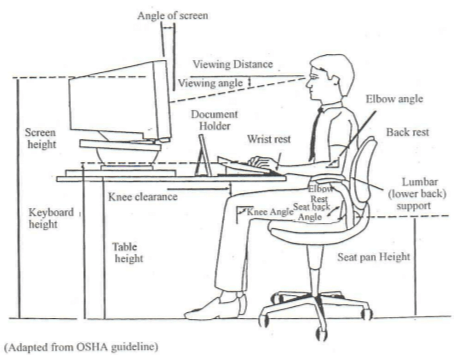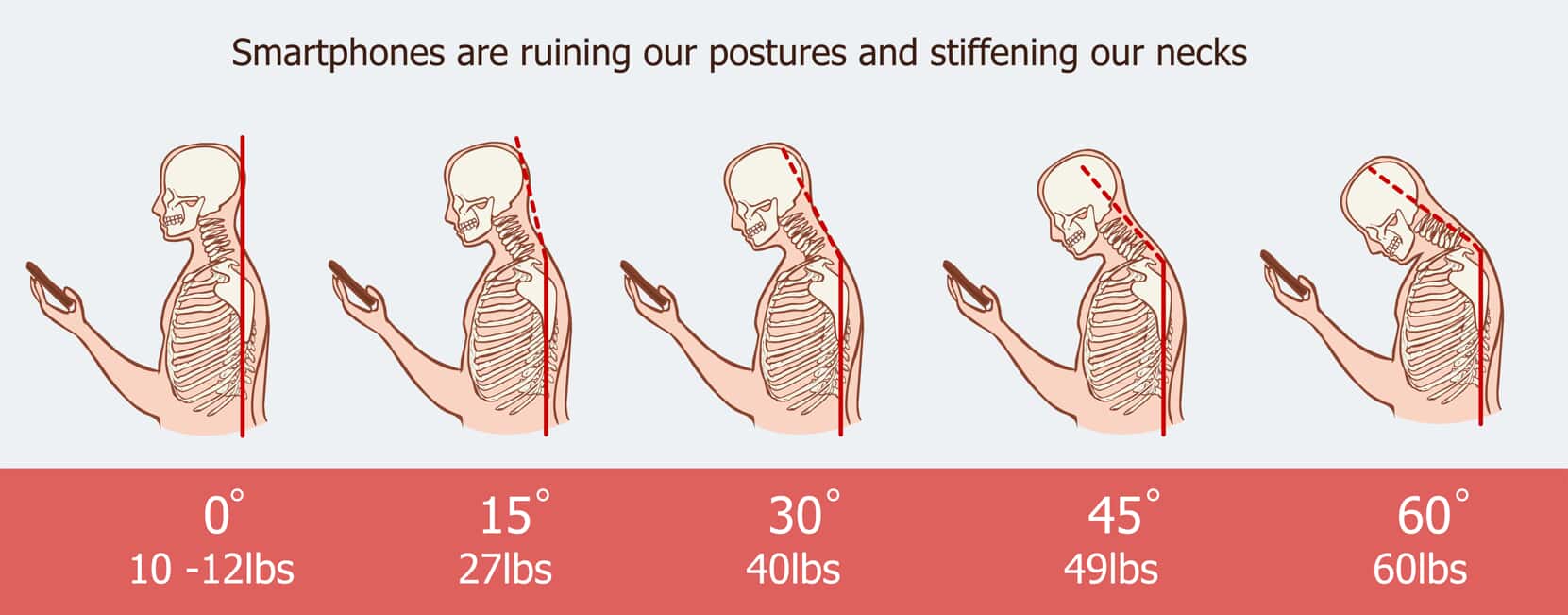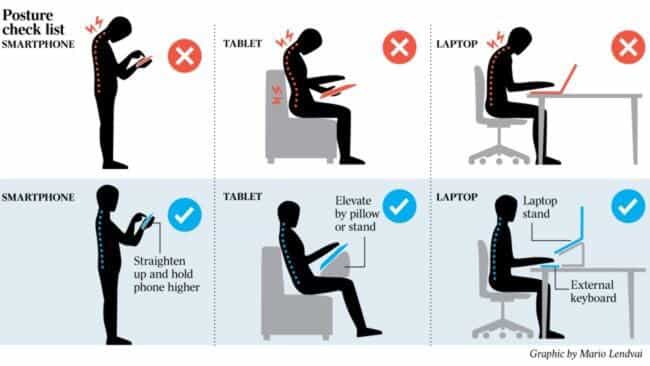Steps for Improving Health, Productivity While Working From Home
- Category: Did You Know?
- Posted On:

Working or completing school from home has quickly become a normal part of our everyday lives.
Meetings in a confined room have moved to a virtual platform. Walking to a neighboring office to ask a question has now turned into an email or phone call. Another difference is the comfort of being able to work from furniture in your own home.
While couches, recliners, and your bed may seem like more ideal places to complete your work, you may actually be causing more strain on your body than necessary. Valley Health’s Cindy Quinnelly is an Occupational Therapist specializing in hand therapy. She is also a Certified Ergonomic Assessment Specialist. Part of her work includes traveling to businesses across the region and assessing office spaces within the Valley Health System to discover what could be causing a worker’s muscle or joint discomfort, headaches, eye strain or other issue.
“A lot of times it’s just a matter of adjusting the monitor height and angle – then having the client relax their shoulders and arms. That way their shoulders are not elevated and active. I think sometimes people think headaches are only related to staring at the screen, but overusing larger muscles to accommodate your posture at your work station can also lead to headaches.”
Before she meets with clients, Quinnelly gives out a comfort survey to the client to note the areas of the body discomfort during the course of a workday.
“They’re having a lot of discomfort either toward the end of the work day or even at the beginning of the day. If they start having issues right away, there are probably some posture violations at the work station. I would say the number one issue is the posture of the neck.”
Quinnelly notes the neck as one of the top areas of concern for her patients, along with head, shoulders, and elbows.
“At work, you have an adjustable chair and probably a decent set up with your desk, monitor, and keyboard. At home, everything has changed completely. I think one of the biggest issues is most clients don’t have personal computers at home. The laptop is far more popular, but it needs to be elevated. You want to keep the elbows at about a 90 degree angle with your body and straight wrists. That way you have a comfortable angle without awkward posture. You also want to have your knees at a 90 degree angle. Be sure to sit back in your chair to get that lumbar support.”

Desk tips:
- Position the hips and knees at 90 degree angles with your feet supported.
- Avoid reaching for the computer mouse. Bring it closer to you so you don’t have to lean over to use it.
- Position the computer monitor 24-26 inches from your eyes. The top of the monitor should be at eye level.
- Good hand positioning and techniques are important when keyboarding and using the mouse. Your fingers should be slightly bent upward with the fingers falling in a gentle curve.
- Allow your hands to float over the keyboard.
Video: “Home Office Ergonomics for Sitting or Standing Desks” from ChoosePT
For lumbar support, Quinnelly suggests placing a rolled towel in your lumbar area. A towel usually works better than a pillow because it will support the natural lumbar curve. Using a separate, Bluetooth keyboard is also recommended. This will allow you to place your laptop screen higher than your keyboard, creating healthy head and arm angles.
Taking breaks to walk around is also highly recommended. There are several easy, quick stretches you can do to help alleviate pressures on your body often associated with long periods of sitting.
“I encourage my clients to get out of their chair about 30-45 minutes into their day to move around. I also encourage people to apply the same principles of their sitting position while standing. It gives them a chance to have a rest break from constant sitting, which can put a lot of strain on your lower back. Use your kitchen countertop or bar area to stand while working. This will add variation to your work day.”

Valley Health physical therapist Michelle Young, PT, OCS, Cert MDT, says sometimes you may need assistance identifying what is causing your discomfort. A lot of times, it only takes one or a few appointments to get to the root of the issue.
“I was recently treating a patient who is a professor and now online all of the time,” Young says. “I’m treating her for neck discomfort and I asked her to bring pictures of her home office set up. Being able to talk to her about her pictures of her home set up and what total alignment would look like was very helpful. We found out the issue wasn’t her desk, but her chair. There are all sorts of things that are simple to adjust and can make a huge difference.”
- Video: “Exercise Posture Break for Office Workers” from ChoosePT
- Video: “5-minute Break – Office Yoga” from Beyoutifulliving
“In general, I think a lot of people can do certain small things to eradicate some of those posture issues,” Quinnelly adds. “Education, learning how to do things a little bit differently, and identifying what needs to be done differently. If we can get those things taken care of early, they resolve themselves pretty well. That’s why we like to catch things early on.”
Headaches can also be caused by the lighting in your home office. Florescent lighting is frequently used in office spaces and public areas because of how well it can illuminate a room. However, health experts like Quinnelly say florescent lighting could be linked to frequent headaches and eye strain.
“Taking a client out of an office cubicle with a lot of florescent lighting and into a space with natural or task lighting seems to be really helpful. In terms of the home office, people seem to like to use their kitchen or dining rooms. If they have a lot of light that is coming from the back, it’s going to put a lot more glare on their screen. So, I’ll give them a suggestion of closing blinds or using task lighting for better illumination.”
Task lighting illuminates a specific, smaller area such as a desk light or a lamp. YLighting provides lighting tips for your home office workspace. The National Headache Foundation also weighs in on light triggers and photophobia in an article.
Adults aren’t the only ones spending more time at home and feeling the impact. Most children, adolescents, and young adults across the country are completing school through a hybrid model (mix of online and in-person instruction) or entirely online. Angela Eberle, PT, DPT, PCS, is a pediatric physical therapist with Winchester Rehabilitation.
“Pre-K and early Elementary kids are really lacking overall movement and exercise in general. They used to get up and have floor time at school or recess. Now, they’re expected to sit in one position for anywhere from 45 minutes to an hour and a half or longer a time for class. Middle and high school students are really looking at long hours and poor posture. A lot of times they aren’t set up with a good desk situation. I recently treated a middle school student for what I call ‘tech neck’.”
‘Tech neck’, or ‘technology neck’, is what Eberle describes as the discomfort you feel from looking down at a computer screen or other electronic device for long periods of time. This includes smartphones, which have become a significant part of daily life for people of all ages.

The good news for young students is there are many resources and easy activities available to help relieve the fatigue and pressure from increased technology usage.
“For Pre-K and early elementary, taking breaks during the online school day should look a lot like playtime,” Eberle says. “That means getting out of the chair, moving to different positions, and maybe engaging in a song like the Hokey Pokey. Let loose, get the energy flowing, and do some different postures. You can also show them Cosmic Kids Yoga (link below) for something different.”
Resources for young students at home:
- Cosmic Kids Yoga YouTube channel
- APTA Family Resources for Fun with Physical Activity and Young Children
- APTA Resources on Fitness for Young Children
- AOTA Back to School Guide in the Era of COVID-19
- The OT Toolbox: Brain Breaks
“For middle and high school students, we’re talking more about the same tips you would give an adult working in an office. Get up out of the chair, walking across the room, doing shoulder and neck exercises, and other quick activities can make a huge difference in preventing pain and discomfort from poor posture and prolonged sitting.”
Sometimes seeking relief for work and school-related discomfort takes professional treatment. Valley Health offers physical therapy, occupational therapy, and pediatric care at multiple locations.


